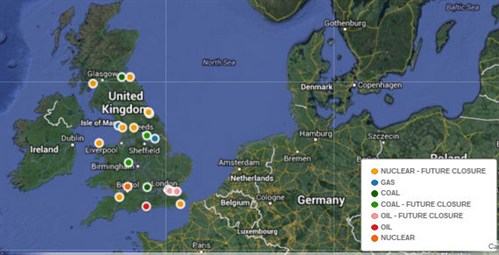
For the first time in 46 years, Kent’s kettles are bubbling away without the help of Tilbury power station’s considerable coal power. On Tuesday morning, amid little fanfare, Tilbury’s turbines spun for the last time. But barely had the soot-tinged tears dried before news of more shutdowns hit the headlines.
While power companies are quick to blame the rise of government-supported renewables for plant closures, in reality the writing has been on the wall for a long time.
Some European policies require old power plants to shut down, and – while economics plays a part – many plants are retired due to inevitable infrastructural ageing.
Coal and oil
About 6.1 gigawatts of UK coal plant capacity is expected to shut down by 2015 due to the European Union’s Large Combustion Plant Directive (LCPD). The LCPD requires plants to reduce sulphur dioxide, nitrogen oxide, and particulate matter emissions. If plants choose not to comply, they can only operate for a further 20,000 hours – and must shut down for good by 2015.
The map below shows which UK plants have closed since 2011, and are expected to close in the next decade (click on it to go to the interactive page).
In the UK, nine plants with a combined generating capacity of around 12 gigawatts have decided to close rather than invest in meeting the standards – including Tilbury. The plug was finally pulled after a long and ultimately fruitless flirtation with biomass conversion.
And it’s not just coal plants that fall foul of the LCPD: three oil plants are set to be closed by 2015, taking 3.5 gigawatts of capacity off the UK grid.
Gas
While gas plants meet the LCPD criteria, increasing numbers of plants across Europe are being temporarily shut down – known as mothballing – as demand wanes.
Germany’s march towards decarbonisation is proving a particular headache for fossil fuel company CEOs. Germany’s robust renewable energy subsidies have led to increasing amounts of wind and solar coming onto the European grid. As renewables have no fuel costs, they depress the wholesale price of electricity, and reduce gas plants’ profitability.
European gas plants have also suffered from cheap US coal flooding the market. In countries such as Germany and the UK, this has led to coal plants rushing to use their remaining LCPD hours while the fuel is cheap, increasing their share of generation and pushing gas out of the mix.
Four gas plants have been mothballed in the UK since 2011 (the blue dots on the map above), with a combined capacity of 4.1 gigawatts. The largest was 1.8 gigawatt station in Teeside, near Middlesborough. National Grid and market regulator, Ofgem, both anticipate further mothballing unless the economic situations changes.
Nuclear
While coal and gas plants are currently getting the headlines, nuclear power plant closures will provide the UK’s largest capacity loss in the next decade.
Old nuclear plants generally have operational lifespans of about 30 years. The UK has a whole fleet of nuclear plants built in the 1970s and 80s which are due to come offline. Oldbury’s 0.4 gigawatt reactor was decommissioned in 2012, the seventh to come offline since 2000. Eight more reactors are due to close by 2025, dotted around the country (the light orange dots), with a combined capacity of around 14 gigawatts.
This isn’t just a problem for power generation – nuclear power plants are also expensive to close. Radioactive materials have to be dealt with, and sites have to be decontaminated, taking up to 60 years. The government agency tasked with overseeing nuclear power plant closures, the Nuclear Decommissioning Authority, has a £3.2 billion budget for 2013-2014 – about half of DECC’s total budget.
Capacity crunch
The extent of closures means the amount of spare power the UK has to call on if there’s a spike in demand, or a power plant unexpectedly shuts down, is expected to get a bit tight in coming years. Ofgem released a report in June which said the risk of power blackouts could increase from one every 47 years now, to one every four years by the middle of the decade.
It’s unlikely Britain’s lights will go out, however. The mothballed gas plants can be reopened quickly, and the government has a range of policies aimed at reducing demand. It is also investing heavily in interconnection to the continent so the UK can take advantage of the increasing amounts of renewable power in Europe when domestic wind turbines aren’t spinning and the sun is stuck behind clouds. As much as 12 gigawatts of Irish, French and Dutch electricity could be flowing onto the UK’s grid by 2020.
Sadly for old friends like Tilbury, nowadays the government is looking beyond the old counties to provide for the UK’s electrical needs.
Update, 16/08/13, 14.30: The figure on what proportion of DECC's budget was made of nuclear decommissioning costs was updated.


